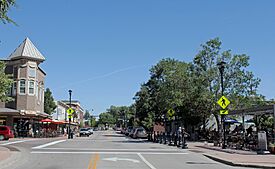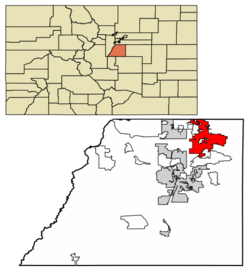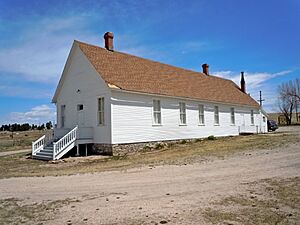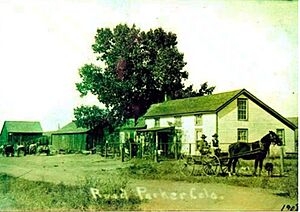Parker, Colorado facts for kids
Quick facts for kids
Parker, Colorado
|
||
|---|---|---|

Mainstreet in downtown Parker
|
||
|
||

Location of Parker in Douglas County, Colorado
|
||
| Country | United States | |
| State | Colorado | |
| County | Douglas | |
| Founded | 1864 | |
| Incorporated | May 1, 1981 | |
| Named for | James Parker | |
| Government | ||
| • Type | Home rule municipality | |
| Area | ||
| • Town | 22.455 sq mi (58.158 km2) | |
| • Land | 22.447 sq mi (58.138 km2) | |
| • Water | 0.008 sq mi (0.022 km2) | |
| Elevation | 5,834 ft (1,778 m) | |
| Population
(2020)
|
||
| • Town | 58,512 | |
| • Estimate
(2022)
|
61,222 | |
| • Rank | US: 633rd CO: 19th |
|
| • Density | 2,727.40/sq mi (1,053.01/km2) | |
| • Urban | 2,686,147 (US: 18th) | |
| • Metro | 2,985,871 (US: 19th) | |
| • Combined | 3,663,515 (US: 18th) | |
| Time zone | UTC–7 (Mountain (MST)) | |
| • Summer (DST) | UTC–6 (MDT) | |
| ZIP Codes |
80134, 80138
|
|
| Area code(s) | 303, 720, and 983 | |
| FIPS code | 08-57630 | |
| GNIS feature ID | 2413117 | |
| Sales tax | 8.0% | |
Parker is a town in Douglas County, Colorado, United States. It's a "home rule municipality," which means it has special powers to govern itself. Parker is the second largest town in Douglas County.
In recent years, Parker has become a commuter town. This means many people who live in Parker travel to work in the larger Denver metropolitan area. In 2020, about 58,512 people lived in Parker. It is now the 19th largest town or city in Colorado.
Contents
History of Parker
Early People and Settlements
The first people known to live in the Parker area were ancient Paleo-Indians and Plains people. By the 1800s, the Utes, Arapaho, and Cheyenne tribes lived here. They were all hunter-gatherers who set up temporary camps to find food. A nearby place called Franktown Cave shows that people lived there as early as 6400 BC.
The Pine Grove Way Station
In 1864, Alfred Butters opened the Pine Grove Way Station. This was a small building where travelers could buy supplies, send mail, and rest. The area was then part of the Colorado Territory. Butters later became a state senator.
George Long and his wife bought the building and moved it to Main Street. They made it much bigger, adding ten rooms and a ballroom. Because it was about 20 miles from Denver, it was called the Twenty Mile House. It offered food, lodging, and safety for early settlers.
At first, Native Americans and settlers got along. However, tensions grew in the 1860s because of broken agreements and misunderstandings. People became worried after some conflicts, and the local school even closed for a short time.
In 1869, Nelson and Susan Doud owned the Twenty Mile House. In 1870, they sold it to James S. Parker. James was a veteran from the American Civil War who came to Colorado in 1865. He added a blacksmith shop and a general store.
In 1870 or 1873, a post office was set up for the Pine Grove settlement, and James Parker became the postmaster. He also built a schoolhouse and paid the teacher's first year's salary. James's brother, George Parker, owned much of the land that became the town. He helped new settlers and businesses by selling them parts of his land.
The Town of Parker is Born
The settlement's name was changed to Parker in 1882. It was first called "Parkers'" after the two brothers, but the apostrophe was later removed. That same year, the Denver and New Orleans Railroad built a train route that connected Denver, Parker, and Colorado Springs. To make sure the train came right through the middle of town, James and George Parker sold their land rights for a very low price.
Around 1884, James Parker gave three acres of land for the Parker Cemetery. His two sons were buried there. Many early settlers are also buried in this cemetery.
More businesses came to Parker in the mid-1880s, including more stores, another blacksmith shop, a place for horses, a barber shop, a creamery (for dairy products), a feedlot (for livestock), a hotel, a church, and a brickworks (for making bricks). Many of these were added by 1900. The train station in Parker closed in 1931.

In the 1960s, a company tried to develop a "modern western town" in Parker, but they ran out of money. Another builder finished the project around 1980 or 1981. Dean Salibury helped Parker become an official town to protect its landowners. The town was officially formed in 1981, and Salisbury became Parker's first mayor.
Parker grew very quickly in the 1990s and 2000s. In 1981, only 285 people lived in Parker. By 2014, there were 48,000 people!
Historic Places to Visit

The old Twenty Mile post office building, which was originally the Pine Grove post office, has been restored. You can find it on Mainstreet. The Ruth Memorial Methodist Episcopal Church is also a very old and important building. The town of Parker also worked to restore the Parker Consolidated School, which is now the Mainstreet Center. Other historic spots include the Hood House, Tallman–Newlin Cabin, and Parker Cemetery.
Geography and Climate
Where is Parker?
Parker is located in the northeastern part of Douglas County, Colorado. Its northern border is next to Arapahoe County, and the city of Aurora is close to its northeast side. Parker is about 23 miles southeast of downtown Denver. Castle Rock, which is the main town in Douglas County, is about 15 miles southwest.
Parker sits at an elevation of about 5,900 feet above sea level. This means it's quite high up! Cherry Creek flows through Parker on its way north toward Denver.
Parker's Climate
Parker has a semi-arid climate. This means it's usually drier than many places, but it gets more rain than a true desert. It has cooler, wetter weather because of its location. The amount of rain can change a lot from year to year.
| Climate data for Parker, Colorado | |||||||||||||
|---|---|---|---|---|---|---|---|---|---|---|---|---|---|
| Month | Jan | Feb | Mar | Apr | May | Jun | Jul | Aug | Sep | Oct | Nov | Dec | Year |
| Mean daily maximum °F (°C) | 43 (6) |
46 (8) |
51 (11) |
60 (16) |
69 (21) |
80 (27) |
86 (30) |
84 (29) |
77 (25) |
66 (19) |
52 (11) |
45 (7) |
63 (18) |
| Mean daily minimum °F (°C) | 15 (−9) |
18 (−8) |
23 (−5) |
31 (−1) |
40 (4) |
49 (9) |
55 (13) |
54 (12) |
46 (8) |
35 (2) |
23 (−5) |
17 (−8) |
34 (1) |
| Average precipitation inches (mm) | 0.3 (7.6) |
0.3 (7.6) |
0.9 (23) |
1.3 (33) |
2.5 (64) |
1.9 (48) |
2.2 (56) |
1.9 (48) |
1.1 (28) |
0.8 (20) |
0.7 (18) |
0.3 (7.6) |
14.1 (360) |
| Source: Weatherbase | |||||||||||||
People of Parker
| Historical population | |||
|---|---|---|---|
| Census | Pop. | %± | |
| 1980 | 290 | — | |
| 1990 | 5,450 | 1,779.3% | |
| 2000 | 23,558 | 332.3% | |
| 2010 | 45,297 | 92.3% | |
| 2020 | 58,512 | 29.2% | |
| 2022 (est.) | 61,222 | 35.2% | |
| U.S. Decennial Census 2020 Census |
|||
As of 2022, about 61,222 people live in Parker. There are over 20,000 households. Many families live in Parker, with about 45% of households having children under 18. Most households are made up of married couples.
The average household in Parker has about 2.85 people. The median age in Parker is 31 years old. This means half the people are younger than 31, and half are older. About 28.3% of the population is under 18 years old.
Education in Parker
Parker is part of the Douglas County School District. This school district is known for having high-achieving students in Colorado. Students in this district often score much higher than the state average on tests. In 2009, the district was ranked 9th in the state.
Two of the main high schools in Parker, Ponderosa and Chaparral High School, have a fun rivalry. They compete each year for "The Pride of Parker" trophy. Legend High School opened in 2008 as the ninth high school in Douglas County.
Private Schools in Parker
- Ave Maria Catholic School (Pre-kindergarten to 8th grade)
- Southeast Christian School (Pre-kindergarten to 8th grade)
- Lutheran High School Parker (9th to 12th grade)
- Parker Montessori Educational Institute (Pre-kindergarten to Kindergarten)
- Montessori Academy (Pre-kindergarten to Kindergarten)
Other Schools in Parker
- Pine Lane Primary
- Frontier Valley Elementary School
- Pine Lane Intermediate
- Pine Grove Elementary School
- Mammoth Heights Elementary School
- Cherokee Trail Elementary
- Iron Horse Elementary
- Prairie Crossing Elementary
- Legacy Point Elementary
- Gold Rush Elementary
- Pioneer Elementary School
- Global Village Academy
Middle and High Schools
- Sierra Middle School
- Sagewood Middle School
- Cimarron Middle School
- Legend High School
- Ponderosa High School
- Chaparral High School
Charter Schools
Parker also has six public charter schools. These schools are public but are run independently:
- American Academy
- Challenge to Excellence Charter School
- North Star Academy
- Parker Core Knowledge Charter School
- Leman Academy of Excellence (Kindergarten to 8th grade)
- Parker Performing Arts School (Kindergarten to 8th grade)
Higher Education
For college classes, students can attend:
- The University Center at Chaparral
- Arapahoe Community College (Parker campus)
- University of Colorado South Denver Campus
For advanced degrees, there is:
- Rocky Vista University - College of Osteopathic Medicine
Fun and Recreation
Parker has many great places for outdoor activities! The town has 10 trails that are over 27 miles long. These trails are paved and can be used for walking, biking, and more. There are also over 6 miles of natural trails for horseback riding. The Cherry Creek Trail goes through Parker and is popular for biking, hiking, and even cross-country skiing in winter.
The Rueter–Hess Reservoir is west of town. While you can't use the water for recreation yet, the trails around the reservoir are open for hiking. In the future, people will be able to fish and use non-motorized boats there.
The Parker Recreation Center is a large building with lots of things to do. It has gyms, swimming pools, fitness rooms, and offers many sports and fitness classes.
The Parker Field House is another huge indoor space, with 100,000 square feet! It has sports fields, batting cages, more gyms, and even a climbing area.
If you like tennis or pickleball, the Parker Racquet Club opened in 2019. It has six indoor courts. Soon, it will also have outdoor courts and one of the first paddle courts in Colorado.
Attractions in Parker
Parker has about 250 acres of developed parks and over 900 acres of open space. This means lots of green areas to explore!
The Parker Arts, Culture, & Events Center (PACE) is a popular spot. It hosts art shows, art classes, plays, and concerts. It's also the home of the Parker Symphony Orchestra, which performs many concerts each year.
Parker is also home to the Colorado School of Dance. Every December, they work with PACE to put on "Nutcracker of Parker," a ballet that has been a tradition since 2003.
Local News
Parker has a local magazine called Search Parker Magazine and a local newspaper called the Parker Chronicle. You can also watch Douglas County 8, a county-wide TV channel that shows school sports and other local programs.
Famous People from Parker
Many interesting people have lived in or were born in Parker, including:
- Josh Adams (born 1993), a basketball player
- Bobby Dalbec (born 1995), a baseball player
- Hayden Dalton (born 1996), a basketball player
- Scott Elrod (born 1975), an actor
- John Grant (born 1968), a singer-songwriter
- Milan Hejduk (born 1976), a former ice hockey player who won the Stanley Cup in 2001
- John C. Malone (born 1941), a very successful media business owner
- Dana Perino (born 1972), who used to be the White House Press Secretary
- Derrick White (born 1994), an NBA basketball player
See also
 In Spanish: Parker (Colorado) para niños
In Spanish: Parker (Colorado) para niños




